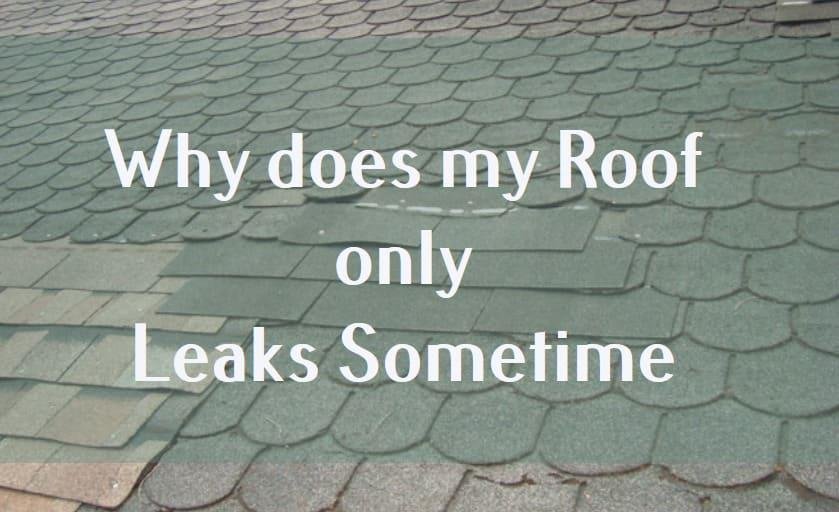When facing the wind and rainy seasons, you may sigh, why does my roof only leak sometimes? Well, there are several answers to such a question. Thus, if you want to know them, perhaps the information below can be helpful to you. It is because of those that comprise some brief explanations of why your roof can have intermittent roof leaks.
Why Is My Roof Leaking?
There are several reasons why a roof leaks sometimes. You may find one, two, or three similar to yours at home.
- Holes
Any hole in the roof is an obvious place for water to enter. Nothing prevents it from entering your property.
If you do not maintain the roof, holes might form over time. They might also occur unexpectedly if something ever strikes your roof.
- Missing or Damaged Shingles
Shingles preserve the roof and direct water away from it towards the gutters. Whether they are hacked in any manner, they will be unable to perform their duties, perhaps allowing leaks.
Quite often, the harm begins right away. Leaks can occur if the placement of shingles or roofs is not proper. Malfunctioning roofing materials might potentially cause leaking from the start.

- Gutter Issues
When you ask, “Why does my roof only leak sometimes?” maybe the answer is gutter problems. Water drains from the roof and then into your gutters. Those gutters can also collect twigs, leaves, and other garbage.
Whenever you do not clean the gutters regularly, dirt accumulates and prevents water from running. Water can accumulate on the roof, which it can penetrate the shingles and cause leaks.
- Old Age
Because of wear and tear, your roof will ultimately need roof replacement. The lifespan of a roof is related to the roofing material chosen.
The roof can grow fragile and disintegrate as it ages. This stops it from preventing leaks in your house.
- Flashing Damage
This one is metal, which sits over joints and seams to prevent leaks. However, it can also be a source of leakage.
- Roof Slope Issues
Finding the answer to why my roof only leaks sometimes? A flat roof can also exacerbate the leakage. The roof’s pitch aids in the effective outflow of water. If the roof has a low pitch, water might slow down and pile up on the roof structure, subsequently leaking into your property.
- Ridge Caps and Valleys
The highs and lows on the roof contribute to an architectural style, and they also present possible water entrance places. Whether you detect leaks in such sections of your property, you might have had a problem with how they are insulated.
- Roof Debris
Leaves, branches, as well as other debris, prevent water from properly draining off the roof. This can lead to water stagnating on that roof or even backing up behind the shingles. Water might seep through the roofs and inside your property.
Roof Only Leaks During Heavy Rain
When heavy rains fall, you may find a certain leak where the roof meets the wall or anywhere else inside your property. Perhaps the problem may be caused by the reasons below.
- Plumbing
A vent pipe and flashing are found wherever there is plumbing. Due to their plumbing configuration, certain properties may be more susceptible to leakage when it rains heavily. A leak can happen in anything as basic as a circulation fan duct.
- Chimney
Roof leaks are significantly more likely in a property featuring a chimney than in one without. Water can enter the chimney directly, via the brick surface, or via angled flashing in between the roof and the chimney. Roof shingle issues only enhance the probability of leakage.
- Skylights
Skylights are also another typical source of leakage, often owing to faulty or badly fitted flashing, cracks around the structure, or moisture pouring off an uninsulated skylight.
- Metal corrosion
Metal fractures with rust surrounding fasteners might provide enough room for fluids to seep. Metal roof seams can become loose due to expansion and contraction over time. This deterioration may potentially result in leaks.
- Condensation
Attics that are not adequately vented can cause wet, heated air to accumulate. Another issue with condensation in pipes that vent through the roof is excessive rain. The water subsequently leaks into the attic and drips over the ceiling. Rainy seasons on briefly milder winter days may exacerbate the problem.
Roof Leaks Caused Only When the Wind Blows
Roof tile fractures do not have to be large to create substantial leakage. Hairline fractures in tiles can also cause leaks, commonly known as “splits.” Wind will pelt your roof, allowing water to escape through any breaches, regardless of how small.
You can check some tutorials about solving leakages or contact professional roofing help.


